Positive electrode for lithium ion secondary battery and lithium ion secondary battery
- Summary
- Abstract
- Description
- Claims
- Application Information
AI Technical Summary
Benefits of technology
Problems solved by technology
Method used
Image
Examples
examples
“Example 1”
[0079]80 parts by mass of Li2CO3 as a lithium compound and 20 parts by mass of carbon nanotubes (CNTs) as fibrous carbon were prepared. An average particle size of the lithium compound was 1 μm. Am average diameter of the carbon nanotubes was 0.6 nm and an average length thereof was 10 μm.
[0080]Subsequently, a solution in which carbon nanotubes were dispersed was sprayed on this lithium compound. When the dispersion was dried, a composite powder in which carbon nanotubes were attached to the surface of the lithium compound was prepared.
[0081]Subsequently, the composite powder, the positive electrode active material, the conductive auxiliary agent, and the binder were mixed to prepare a positive electrode mixture. Lithium cobalt oxide (LiCoO2) was used as the positive electrode active material, carbon black was used as the conductive auxiliary agent, and polyvinylidene fluoride (PVDF) was used as the binder. A mass ratio of the positive electrode active material, the compo...
example 2
[0088]Example 2 is different from Example 1 in that an average particle size of a lithium compound used in a composite powder was 8 μm. Other conditions were the same as in Example 1 and an overcharge test and a decomposition evaluation were performed.
[0089]A maximum arrival temperature of a lithium ion secondary battery of Example 2 was 80° C. In Example 2, it was confirmed that a carbon network made of fibrous carbon was formed in the positive electrode active material layer and it was confirmed that the average diameter of the pores surrounded by the carbon network was 8 μm.
example 3
[0090]Example 3 is different from Example 2 in that an average diameter of carbon nanotubes used in a composite powder was 150 μm. Other conditions were the same as in Example 1 and an overcharge test and a decomposition evaluation were performed.
[0091]A maximum arrival temperature of a lithium ion secondary battery of Example 3 was 82° C. In Example 3, it was confirmed that a carbon network made of fibrous carbon was formed in the positive electrode active material layer and it was confirmed that the average diameter of the pores surrounded by the carbon network was 8 μm.
PUM
 Login to View More
Login to View More Abstract
Description
Claims
Application Information
 Login to View More
Login to View More - R&D
- Intellectual Property
- Life Sciences
- Materials
- Tech Scout
- Unparalleled Data Quality
- Higher Quality Content
- 60% Fewer Hallucinations
Browse by: Latest US Patents, China's latest patents, Technical Efficacy Thesaurus, Application Domain, Technology Topic, Popular Technical Reports.
© 2025 PatSnap. All rights reserved.Legal|Privacy policy|Modern Slavery Act Transparency Statement|Sitemap|About US| Contact US: help@patsnap.com



